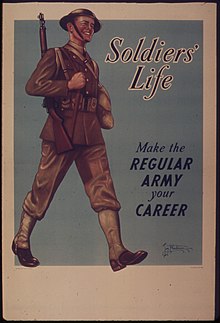
Back Regular Army (USA) Danish Regular Army French Exército Regular (Estados Unidos) Portuguese Regularna vojska (ZDA) Slovenian กองทัพประจำการ (สหรัฐ) Thai Регулярна армія США Ukrainian

The Regular Army of the United States succeeded the Continental Army as the country's permanent, professional land-based military force.[1] In modern times, the professional core of the United States Army continues to be called the Regular Army (often abbreviated as "RA"). From the time of the American Revolution until after the Spanish–American War, state militias and volunteer regiments organized by the states (but thereafter controlled by federal authorities and federal generals in time of war) supported the smaller Regular Army of the United States. These volunteer regiments came to be called United States Volunteers (USV) in contrast to the Regular United States Army (USA). During the American Civil War, about 97 percent of the Union Army was United States Volunteers.
In contemporary use, the term Regular Army refers to the full-time active component of the United States Army, as distinguished from the Army Reserve and the Army National Guard. A fourth component, the Army of the United States, has been inactive since the suspension of the draft in 1973 and the U.S. armed forces became an all-volunteer armed force.[2]
The American military system developed from a combination of the professional, national Continental Army, the state militias and volunteer regiments of the American Revolutionary War, and the similar post-Revolutionary War American military units under the Militia Act of 1792. These provided a basis for the United States Army's organization, with only minor changes, until the creation of the modern National Guard in 1903.[3] The Militia Act provided for the use of volunteers who could be used anywhere in time of war, in addition to the State militias who were restricted to local use within their States for short periods of time. Even today's professional United States Army, which is augmented by the Army Reserve and Army National Guard, has a similar system of organization: a permanent, professional core, and additional units which can be mobilized in emergencies or times of war.
- ^ Johnson, Mark W., That Body of Brave Men: The U.S. Regular Infantry and the Civil War in the West, p. ix. Cambridge, MA: Da Capo Press, 2003.
- ^ Bailey, Beth, "America's Army: Making the All-Volunteer Force", Belknap Press; (November 23, 2009)
- ^ Wright, Jr., Robert K. and Morris J. MacGregor, Jr. Soldier-Statesmen of the Constitution, Center of Military History, United States Army, Washington, D.C., 1987, First Printing-CMH Pub 71-25. Retrieved September 28, 2010.
© MMXXIII Rich X Search. We shall prevail. All rights reserved. Rich X Search